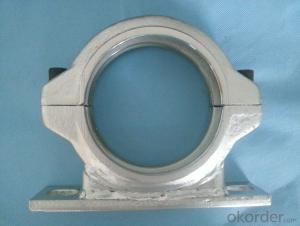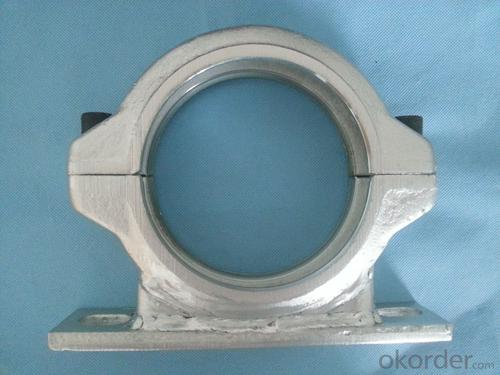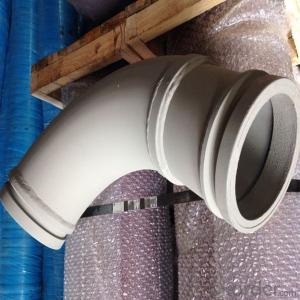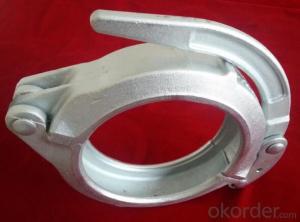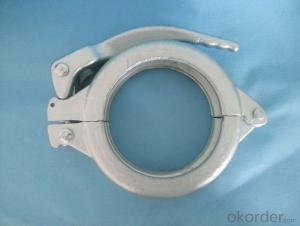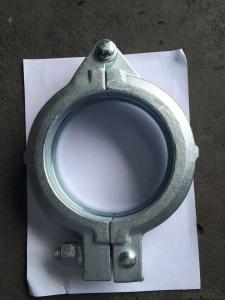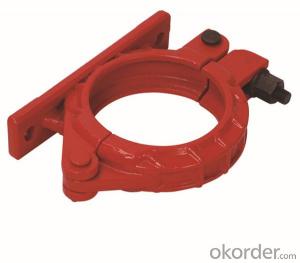Concrete Pump Base Clamp DN125 Forge
- Loading Port:
- China main port
- Payment Terms:
- TT OR LC
- Min Order Qty:
- 20 PCS
- Supply Capability:
- 10000 PCS/month
OKorder Service Pledge
OKorder Financial Service
You Might Also Like
Product Description:
A coupling is a device used to connect two delivery pieps together at their ends for the purpose of transmitting, and prevent the concrete from leaking. Couplings do not normally allow disconnection of shafts during operation.
Main Product Features:
1. use high quality steel. After high-temperature 1200 forging,it’s shaped.
2.High temperature forging.
3.convenient to use, easy operation,and high safety.
4.good sealing,wear-resising,longer service life.
5.do not restrict the steering tubes, pipes during the working process can be 360 degrees rotation.
6.used in concrete pump truck,concrete pump and pipeline connection seal in construction
work equipment.
Product Specifications:
1.Forged
2.2--8 inch
3.Galvanizing/Baking varnish
4.More durable,light,beautiful
Production steps
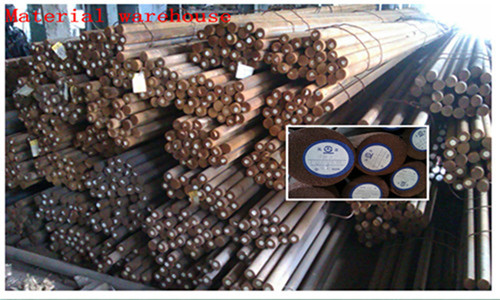

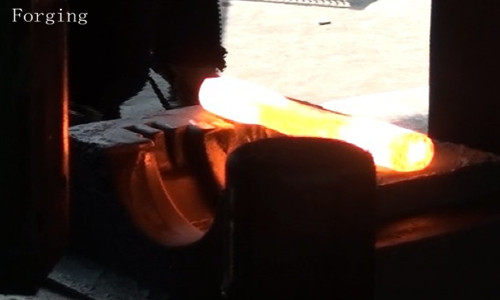
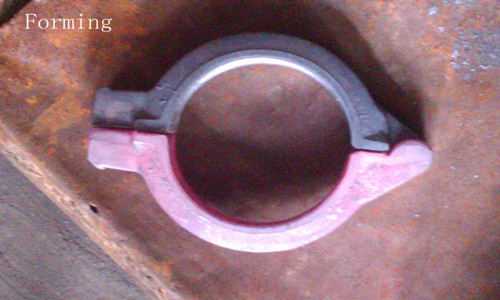

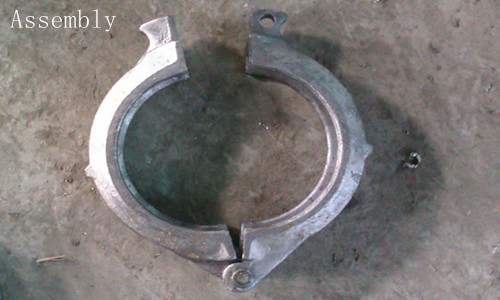
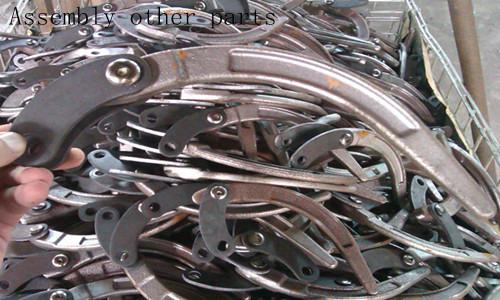
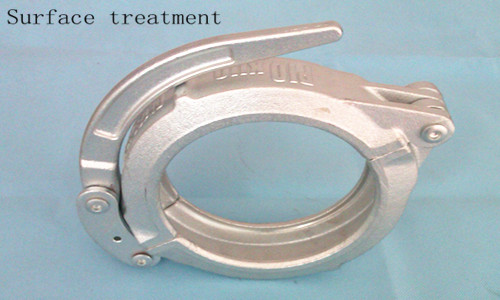
Concrete pump clamp Catalogue
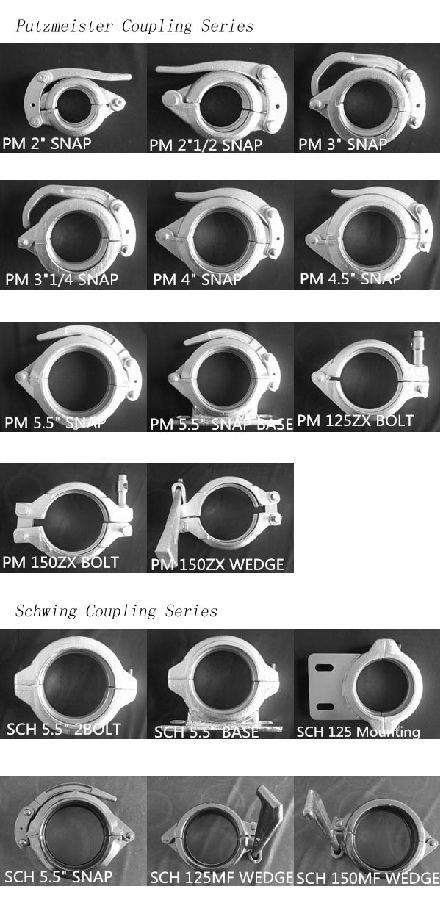
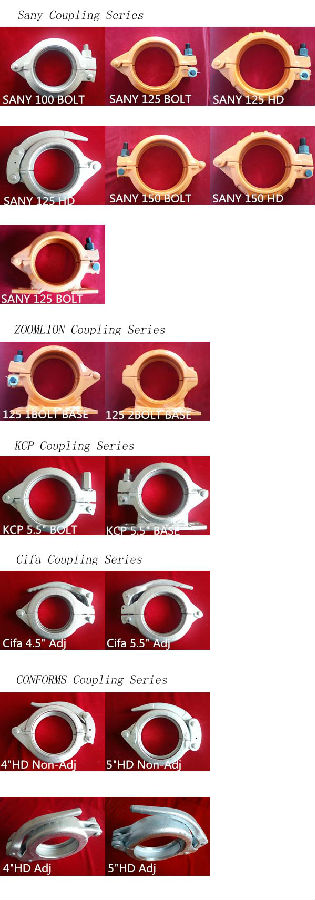
FAQ
1.How do you regarding your product quality?
As our principle is more safety to save more. In China, there are lots of manufactures of this line, but we are the first one that use the forging technic in producing, firmly meet the PM standard.
2.Can I get some samples?
Of course you can. Small sample for free, but you pay the express. For some products are not small, like concrete pump pipe, it’s very difficult to deliver one pipe of 3000mm. If it’s possible, we’d like that you can come here to visit our factory. Welcome!
3. I want to make our logo on the products, is that ok?
Yes, it’s totally ok. OME is available from us.What you should do is send your logo, brand name, or picture to us. And let other things leave on us.
- Q: Are there any special tools required for replacing concrete pump spare parts?
- Special tools are necessary for replacing concrete pump spare parts. The required tools differ based on the specific part being replaced. However, some commonly used tools include wrenches, sockets, hydraulic jacks, cranes or hoists, and torque wrenches. Certain parts may also necessitate specialized tools like concrete saws, chisels, or drills to remove old parts or prepare surfaces for installation. To ensure proper replacement of concrete pump spare parts, it is crucial to refer to the manufacturer's guidelines or seek professional advice.
- Q: Can concrete pump spare parts be customized for specific pump models?
- Yes, concrete pump spare parts can be customized for specific pump models. Different pump models may have varying specifications and requirements, so it is essential to have spare parts that are specifically designed and tailored to fit the unique needs of each pump model. Customized spare parts ensure optimal performance, efficiency, and compatibility with the specific pump model, ultimately enhancing the overall functionality and lifespan of the pump.
- Q: What are the consequences of using substandard concrete pump spare parts?
- There are several consequences to using substandard concrete pump spare parts. Firstly, these parts may not fit properly or be of the same quality as the original ones, which can lead to a decrease in the overall performance and efficiency of the pump. This can result in the pump being unable to deliver the necessary amount of concrete or experiencing frequent breakdowns, causing project delays and higher costs. Secondly, substandard parts may have a shorter lifespan compared to genuine parts. This means that they may wear out or break down sooner, requiring more frequent replacements. This not only increases maintenance costs but also raises the risk of unexpected equipment failures during operation, which can be hazardous for workers and potentially cause accidents. Moreover, the use of substandard parts can compromise the safety of the concrete pump. Genuine parts are designed and manufactured to meet strict quality standards and ensure proper equipment functioning. In contrast, substandard parts may not undergo the same rigorous testing and quality control measures, making them less reliable and more prone to failure. This poses a serious risk to operators and other personnel working near the concrete pump. Additionally, the use of substandard parts can void any warranties or guarantees provided by the manufacturer. Manufacturers typically offer warranties on their products to ensure customer satisfaction and provide support in case of any issues. However, if substandard parts are used, the manufacturer may refuse to honor the warranty, leaving the owner responsible for any necessary repairs or replacements. To summarize, the use of substandard concrete pump spare parts can lead to reduced performance, increased maintenance costs, greater accident risks, and voided warranties. It is crucial to always use genuine parts specifically designed for the concrete pump to ensure optimal performance, longevity, and safety.
- Q: Can concrete pump spare parts be repaired or refurbished?
- Yes, concrete pump spare parts can be repaired or refurbished. Many common spare parts such as seals, bearings, valves, and hydraulic components can be repaired or refurbished to extend their lifespan and save costs. Repairing or refurbishing these parts can involve replacing worn-out or damaged components, reconditioning or re-machining certain parts, and performing necessary maintenance and testing to ensure their proper functionality. Additionally, some manufacturers or specialized companies may offer services for repairing or refurbishing specific concrete pump spare parts, allowing for a more cost-effective solution compared to purchasing brand new parts. However, it is important to note that not all spare parts can be repaired or refurbished, especially if they are severely damaged or have exceeded their recommended service life. In such cases, it may be more practical and safer to replace the parts with new ones.
- Q: What are the indications of a damaged concrete pump boom?
- There are multiple signs that can indicate a damaged concrete pump boom. These signs encompass: 1. Physical damage that is visible: One of the most apparent indications of a damaged concrete pump boom is the presence of visible physical damage. This can manifest as cracks, dents, or deformities in the structure of the boom. It is crucial to take any signs of structural damage seriously as they have the potential to compromise the integrity of the boom. 2. Leaks: Another sign of a damaged boom is the occurrence of leaks. If you observe hydraulic fluid or water leaking from the boom, it could be an indication of damage to the hose or fitting. Leaks not only impact the pump's performance but also pose a safety hazard to the operator and those in the vicinity of the equipment. 3. Misalignment: A damaged boom might also display issues with misalignment. If the boom is not straight or appears to be bent at an unusual angle, it could signify damage. Misalignment can negatively affect the accuracy and efficiency of concrete placement, which could result in uneven or improper pouring. 4. Unusual noises: Unusual or excessive noises during operation can be a sign of a damaged boom. Sounds such as rattling, grinding, or squealing may indicate loose or worn-out components like pins, bushings, or bearings. It is important not to ignore these noises as they could worsen if not promptly addressed. 5. Decreased performance: A damaged boom can also lead to reduced performance. If you notice a decrease in pumping capacity or encounter difficulties in controlling the movement of the boom, it could signify damage. Poor performance can stem from various issues, including problems with the hydraulic system, structural damage, or worn-out parts. To conclude, regular inspections and maintenance of concrete pump booms are vital in order to identify any signs of damage. Addressing these issues promptly is essential to ensure the safety of operators, prevent further damage, and uphold the efficiency and performance of the equipment.
- Q: Can concrete pump spare parts be replaced individually, or should they be replaced as a set?
- Concrete pump spare parts can typically be replaced individually, without the need to replace the entire set. This is beneficial as it allows for cost-effective maintenance and repair of the concrete pump. By replacing only the specific part that is faulty or worn out, operators can ensure that the pump continues to function optimally without incurring unnecessary expenses. Additionally, replacing parts individually allows for better flexibility and customization, as different components may wear out at different rates depending on their usage. However, it is important to note that some manufacturers may recommend replacing certain parts as a set or in specific combinations for optimal performance. Therefore, it is always advisable to consult the manufacturer's guidelines or seek professional advice when replacing concrete pump spare parts.
- Q: Are there any specific warranty options available for concrete pump spare parts?
- Yes, there are specific warranty options available for concrete pump spare parts. Many manufacturers and suppliers offer warranties on their products to provide customers with peace of mind and assurance of quality. The specific warranty options may vary depending on the manufacturer or supplier, but they generally cover defects in materials or workmanship. It is recommended to carefully review the warranty terms and conditions before purchasing concrete pump spare parts to understand what is covered and for how long. Some warranties may provide a limited duration of coverage, while others may offer extended warranties for an additional cost. Additionally, it is important to follow the recommended maintenance and usage guidelines to ensure the warranty remains valid. In case of any issues or concerns with the spare parts during the warranty period, customers can typically contact the manufacturer or supplier for assistance.
- Q: How can a faulty pressure gauge affect the concrete pumping process?
- A faulty pressure gauge can significantly impact the concrete pumping process in several ways. Firstly, it may provide inaccurate readings, leading to an incorrect assessment of the pressure within the system. This can result in either excessively high or low pressure being applied during the pumping process, which can lead to various issues. If the faulty pressure gauge displays a higher pressure than the actual value, it may cause over-pressurization of the concrete pump. This can lead to potential damage to the equipment, such as burst hoses or pipes, which can be dangerous for workers nearby. Additionally, excessive pressure can cause the concrete to be pumped too forcefully, potentially leading to the material splattering or leaking from the delivery system, resulting in wastage and an uneven distribution of the concrete. On the other hand, an incorrectly low pressure reading from the faulty gauge can have its own set of problems. Insufficient pressure within the pumping system can result in the concrete not being adequately delivered to the desired location. This can cause delays in the construction process and result in uneven or incomplete concrete placement, affecting the integrity and strength of the structure being built. Moreover, a faulty pressure gauge may also contribute to inaccurate monitoring of the concrete's slump or consistency. The pressure gauge is often used as an indicator of the concrete's flowability, and if the gauge is faulty, it may provide misleading information about the material's workability. This can result in the concrete mix being either too fluid or too stiff, leading to difficulties in pumping and potentially compromising the quality of the finished concrete structure. In conclusion, a faulty pressure gauge can have severe consequences on the concrete pumping process. It can lead to over-pressurization, material wastage, uneven distribution, delays in construction, and compromised concrete quality. Therefore, it is crucial to regularly inspect and maintain pressure gauges to ensure their accuracy and reliability, promoting safe and efficient concrete pumping operations.
- Q: How often should hydraulic cylinders be inspected or replaced in a concrete pump?
- Hydraulic cylinders in a concrete pump should be inspected regularly, ideally every 500 hours of operation or at least once a year, whichever comes first. However, it is important to note that the frequency of inspections may vary depending on the specific conditions and usage of the concrete pump. During inspections, qualified technicians should thoroughly examine the hydraulic cylinders for any signs of wear, damage, or leaks. They should also check the alignment, piston rods, seals, and other components to ensure proper functioning. If any issues are found, such as excessive wear or leaks, it is recommended to replace the hydraulic cylinders promptly to prevent further damage and maintain optimal performance. Regular inspections and timely replacements of hydraulic cylinders are crucial for ensuring the safety, efficiency, and longevity of a concrete pump. Neglecting proper maintenance can lead to costly repairs, decreased productivity, and even accidents. Therefore, it is essential to follow manufacturer's guidelines and consult with professionals to determine the appropriate inspection and replacement intervals for hydraulic cylinders in a concrete pump.
- Q: What are the signs of a faulty concrete pump control panel?
- There are several signs that can indicate a faulty concrete pump control panel. Firstly, if the control panel is not powering on or experiencing intermittent power loss, it could be a sign of a faulty electrical connection or a malfunctioning power supply. This can prevent the panel from functioning properly and controlling the concrete pump. Secondly, if the control panel is displaying error messages or error codes, it suggests that there may be an issue with the internal components or sensors. These errors can range from minor malfunctions to more serious problems that require immediate attention. Additionally, a faulty control panel may exhibit erratic behavior or unresponsive controls. For example, if the buttons or switches do not respond when pressed, or if they behave inconsistently, it could indicate a problem with the panel's circuitry or wiring. Moreover, unusual noises or vibrations coming from the control panel can be a sign of internal mechanical issues. These could include loose or damaged components, faulty relays, or malfunctioning motors. Lastly, if the concrete pump is not operating as expected, it could be due to a faulty control panel. Inadequate pressure, incorrect flow rates, or difficulty in starting or stopping the pump may all be indicators of a control panel malfunction. In any case, if you suspect that the control panel of a concrete pump is faulty, it is important to consult a professional technician or manufacturer for inspection, diagnosis, and repair.
Send your message to us
Concrete Pump Base Clamp DN125 Forge
- Loading Port:
- China main port
- Payment Terms:
- TT OR LC
- Min Order Qty:
- 20 PCS
- Supply Capability:
- 10000 PCS/month
OKorder Service Pledge
OKorder Financial Service
Similar products
Hot products
Hot Searches
Related keywords
